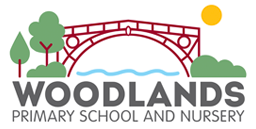Design & Technology
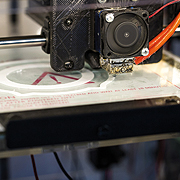
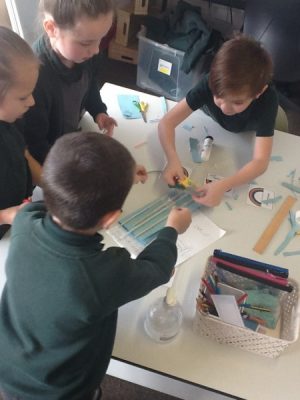 Design and technology is an inspiring, rigorous and practical subject. Using creativity and imagination, pupils design and make products that solve real and relevant problems within a variety of contexts, considering their own and others’ needs, wants and values. They acquire a broad range of subject knowledge and draw on disciplines such as mathematics, science, engineering, computing and art. Pupils learn how to take risks, becoming resourceful, innovative, enterprising and capable citizens. Through the evaluation of past and present design and technology, they develop a critical understanding of its impact on daily life and the wider world. High-quality design and technology education makes an essential contribution to the creativity, culture, wealth and well-being of the nation.
Design and technology is an inspiring, rigorous and practical subject. Using creativity and imagination, pupils design and make products that solve real and relevant problems within a variety of contexts, considering their own and others’ needs, wants and values. They acquire a broad range of subject knowledge and draw on disciplines such as mathematics, science, engineering, computing and art. Pupils learn how to take risks, becoming resourceful, innovative, enterprising and capable citizens. Through the evaluation of past and present design and technology, they develop a critical understanding of its impact on daily life and the wider world. High-quality design and technology education makes an essential contribution to the creativity, culture, wealth and well-being of the nation.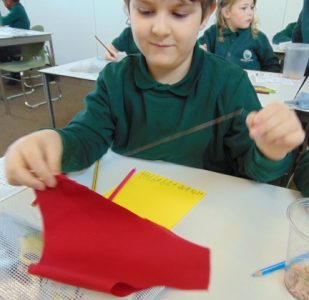
At Woodlands our Design and Technology curriculum is split into five aspects;
- Design- pupils are taught to design products with a purpose, carefully considering the user and their wants and needs. They communicate their ideas through drawings and sketches, annotations, computer-aided designs and discussions.
- Make- From a variety of tools and components offered, pupils can select to meet their desired design and users needs.
- Make: Technical- to work on the technical aspects of design technology, developing an understanding of how to strengthen and stiffen structures and how to use pulleys, gears and levers to create moving parts.
- Make: Nutrition- An opportunity to embed good food hygiene standards, create balanced, healthy and varied diets and follow recipes accurately.
- Evaluate- To analyse their own and existing products. We provide an environment where children can be reflective and discuss the aspects of their product that they are proud of and aspects that they feel could be improved.
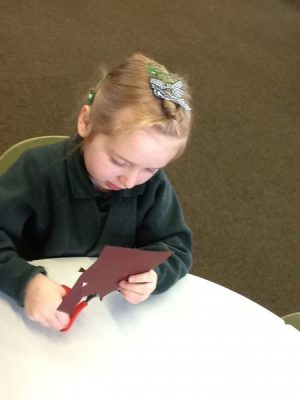 Each term pupils have DT days where they are given the opportunity to design, make and evaluate projects. This can range from cross-curricular work in Science by creating handheld torches to selecting from a range of fabrics to hand sew a waistcoat.
Each term pupils have DT days where they are given the opportunity to design, make and evaluate projects. This can range from cross-curricular work in Science by creating handheld torches to selecting from a range of fabrics to hand sew a waistcoat.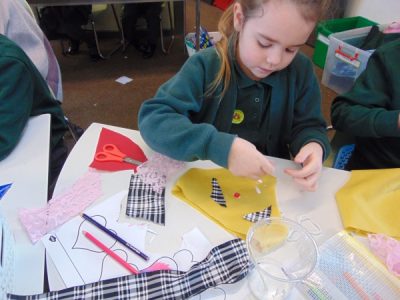
At Woodlands we provide the opportunity for pupils to build upon their prior Design and Technology knowledge that they gain each year and offer a broad variety of projects so that pupils can use their cross-curricular knowledge to support their work. We recognise that all children have strengths in different areas and that by providing a variety of opportunities for children to express their creativity and curiosity we can foster these strengths as they develop throughout the years.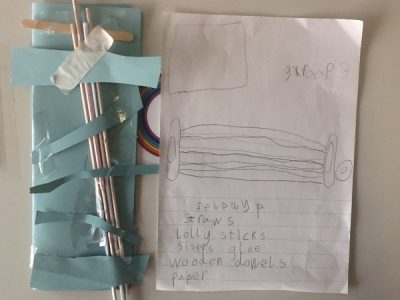
Our curriculum is carefully designed to ensure key knowledge and skills progress in a logical and sequenced way, thus enabling pupils to revisit previously taught content and to build upon it year on year. We use carefully structured progression documents to ensure that substantive and disciplinary knowledge and skills are clearly outlined and sequenced, thus enabling the children to know and remember more, as they move through school.
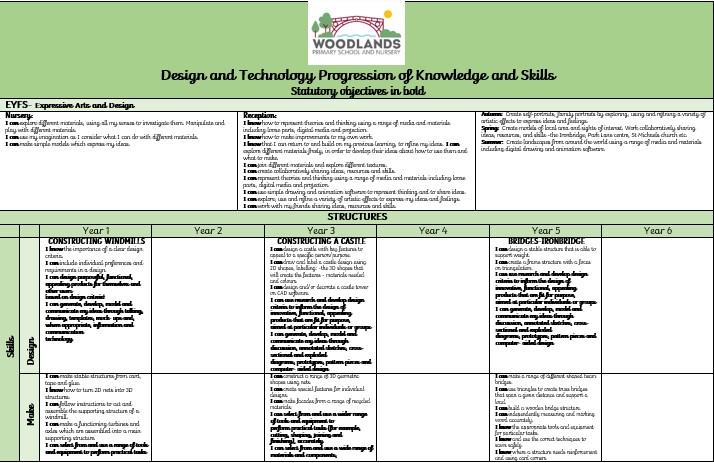
design and technology yearly overview november 22.pdf
Intent
· Design and technology lessons at Woodlands Primary and Nursery School offer children innovative, inspiring and practical opportunities for children to develop inquisitive and curious mind-sets and think critically as they move through the design process.
· Pupils have opportunities to plan, design, make and evaluate products that solve real and relevant problems within a variety of contexts, considering their own and others’ needs, wants and values.
· Children acquire a broad range of subject knowledge and make cross curricular links as they draw on disciplines such as mathematics, science, engineering, computing and art.
· Pupils are encouraged to learn how to take risks, becoming resourceful, innovative, enterprising and capable citizens.
· Through the evaluation of present and past design and technology, children develop a critical understanding of its impact on daily life and the wider world.
· Design and technology lessons are sequential and build progressively on previously learnt skills and knowledge.
Implementation
· The design and technology curriculum follows national guidelines and teaches key substantive and disciplinary knowledge children need, through exciting and engaging projects. D & T is taught half termly, with each year group completing 3 projects per year. Children build on knowledge and skills as they move through year groups, within key areas of DT: mechanisms, structures, textiles, mechanical systems, electrical systems and food.
· Clear and evidential progress is ensured through the use of progression documents across all key stages, to support sequential learning which builds on previously taught skills and knowledge and makes clear links to future learning.
· Teaching and learning follows the design, make and evaluate process and supports the development of technical knowledge.
· Children are supported to have autonomy in the design process, which enables personalisation of products within each unit of learning taught.
· Planning, teaching and learning ensures children recognise each part of the design process.
· Class teachers are empowered to teach design and technology through using KAPOW primary, adapting teaching to meet the needs of the children in their class.
Impact
· The teaching and learning of design and technology is supported by the subject leader and link Governors through: planning monitoring, learning walks, book looks, coaching and pupil voice.
· Teachers are able to plan and deliver, engaging, interactive, creative and high-quality teaching lessons.
· Children can articulate their learning and reasoning and can discuss the design process using accurate terminology and vocabulary.
· Through evidence and assessment, it is evident that teaching and learning has ensured children can evaluate their design in relation to the design criteria.
· Individual products created showcase children’s autonomy within the design process. This has created opportunities for creativity and innovation and an understanding the user’s needs, as pupils reflect on and evaluate their finished products and designs.
· Children show clear enjoyment and develop confidence in design and technology that they can then apply to other areas of learning.
· Children gain a firm foundation of knowledge and skills in design and technology which supports them as they move to KS3.
